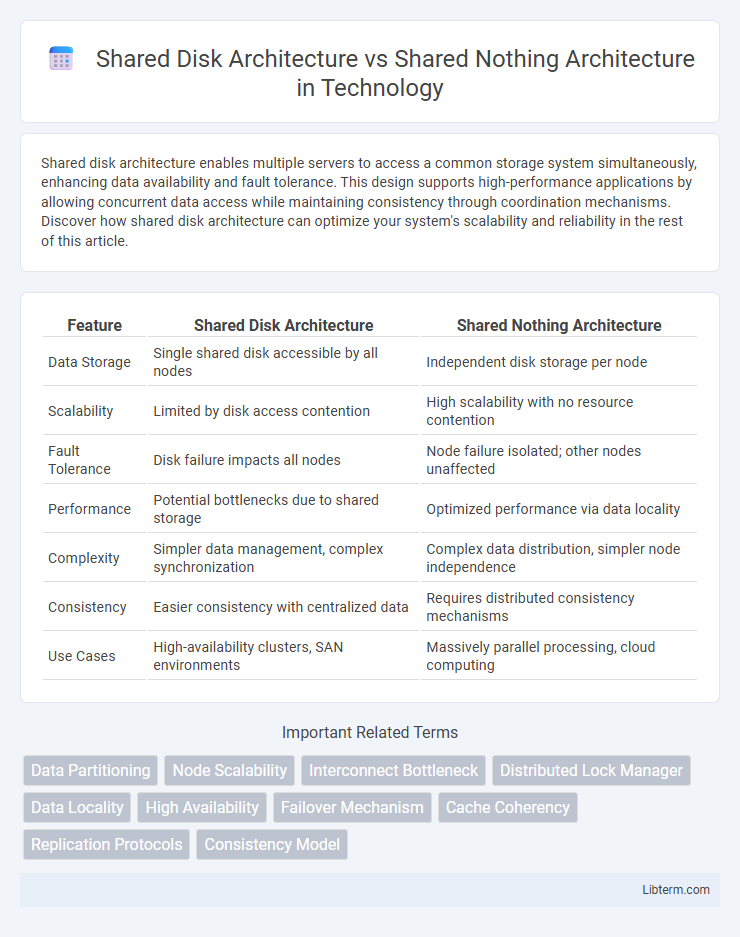Shared disk architecture enables multiple servers to access a common storage system simultaneously, enhancing data availability and fault tolerance. This design supports high-performance applications by allowing concurrent data access while maintaining consistency through coordination mechanisms. Discover how shared disk architecture can optimize your system's scalability and reliability in the rest of this article.
Table of Comparison
| Feature | Shared Disk Architecture | Shared Nothing Architecture |
|---|---|---|
| Data Storage | Single shared disk accessible by all nodes | Independent disk storage per node |
| Scalability | Limited by disk access contention | High scalability with no resource contention |
| Fault Tolerance | Disk failure impacts all nodes | Node failure isolated; other nodes unaffected |
| Performance | Potential bottlenecks due to shared storage | Optimized performance via data locality |
| Complexity | Simpler data management, complex synchronization | Complex data distribution, simpler node independence |
| Consistency | Easier consistency with centralized data | Requires distributed consistency mechanisms |
| Use Cases | High-availability clusters, SAN environments | Massively parallel processing, cloud computing |
Introduction to Data Storage Architectures
Shared Disk Architecture centralizes storage by allowing multiple servers to access the same physical disk array, enhancing data consistency and fault tolerance. Shared Nothing Architecture distributes storage across independent nodes with local disks, promoting scalability and reducing bottlenecks by eliminating resource contention. Both architectures address data storage needs uniquely, influencing performance, availability, and system complexity in large-scale database management.
Understanding Shared Disk Architecture
Shared Disk Architecture centralizes data storage by allowing multiple servers to access the same disk subsystem simultaneously, enhancing data consistency and simplifying management. This design supports high availability and scalability as all nodes share the disk, reducing data duplication and synchronization overhead. It is commonly implemented in clustered database systems where concurrent access and coordination are critical for performance.
Key Features of Shared Nothing Architecture
Shared Nothing Architecture features independent nodes, each with its own CPU, memory, and disk storage, eliminating bottlenecks caused by resource sharing. This design enhances scalability and fault tolerance by distributing both data and workload across multiple servers. Data partitioning and parallel processing are fundamental to its ability to handle large-scale, distributed systems efficiently.
Performance Comparison: Shared Disk vs Shared Nothing
Shared Nothing architecture typically outperforms Shared Disk in scalability and fault isolation by distributing data across independent nodes with local storage, minimizing contention and bottlenecks inherent in shared storage environments. Shared Disk systems face performance degradation under high concurrency due to locking and coordination overhead on the common disk, limiting throughput and increasing latency. In contrast, Shared Nothing enables parallel processing and linear scaling, making it optimal for large-scale, high-throughput database and distributed computing workloads.
Scalability and Flexibility Considerations
Shared Disk Architecture offers high flexibility by allowing multiple nodes to access a common storage, facilitating easy scaling of compute resources without data redistribution, but it may face scalability bottlenecks due to storage contention and network latency. Shared Nothing Architecture provides superior scalability by distributing both data and compute across independent nodes, eliminating storage conflicts and enabling linearly scalable performance; however, it requires complex data partitioning and rebalancing for dynamic scaling. Scalability favors Shared Nothing for large-scale systems, while flexibility in resource allocation and maintenance is typically stronger in Shared Disk setups.
Fault Tolerance and Reliability
Shared Disk Architecture enhances fault tolerance by allowing multiple nodes to access a common disk, ensuring data availability even if one node fails. Shared Nothing Architecture improves reliability through data partitioning and redundancy, isolating failures to individual nodes without affecting the entire system. Both architectures optimize fault tolerance, but Shared Nothing offers superior scalability and isolation for fault containment.
Data Consistency and Management
Shared Disk Architecture centralizes data storage, allowing multiple nodes to access the same disk, which simplifies data consistency management through coordinated locking mechanisms but may introduce contention and bottlenecks under high loads. Shared Nothing Architecture distributes data across independent nodes with separate storage, enhancing scalability and fault tolerance by eliminating shared resource contention but requires complex distributed protocols to ensure data consistency and synchronization. Effective data consistency in Shared Nothing systems relies on distributed transactions and consensus algorithms, while Shared Disk systems manage consistency via centralized locking and cache coherence strategies.
Use Cases and Industry Applications
Shared Disk Architecture is ideal for applications requiring high availability and parallel processing, such as online transaction processing (OLTP) systems and database clusters in financial services and telecommunications. Shared Nothing Architecture excels in scalability and fault tolerance, making it suitable for large-scale web applications, social media platforms, and big data analytics used by e-commerce and cloud service providers. Industries demanding distributed computing and minimal bottlenecks, including retail and healthcare, benefit from Shared Nothing's ability to handle massive data volumes with horizontal scaling.
Pros and Cons: Shared Disk vs Shared Nothing
Shared Disk Architecture offers centralized storage enabling easy data sharing and simplified backup processes, but it faces challenges in scalability and potential bottlenecks due to contention over shared resources. Shared Nothing Architecture provides high scalability and fault isolation by distributing both data and processing across independent nodes, reducing single points of failure, yet it complicates data consistency management and may increase latency during data shuffling. Choosing between the two depends on workload requirements, with Shared Disk suited for environments needing strong consistency and Shared Nothing preferred for large-scale, distributed applications.
Choosing the Right Architecture for Your Needs
Shared Disk Architecture is ideal for applications requiring high availability and fast failover, as multiple servers access a common storage system to ensure data consistency. Shared Nothing Architecture excels in scalability and fault isolation by distributing data and processing across independent nodes without shared storage, reducing contention. Selecting the right architecture depends on workload characteristics, system scalability needs, and tolerance for complexity in data synchronization and management.
Shared Disk Architecture Infographic

 libterm.com
libterm.com